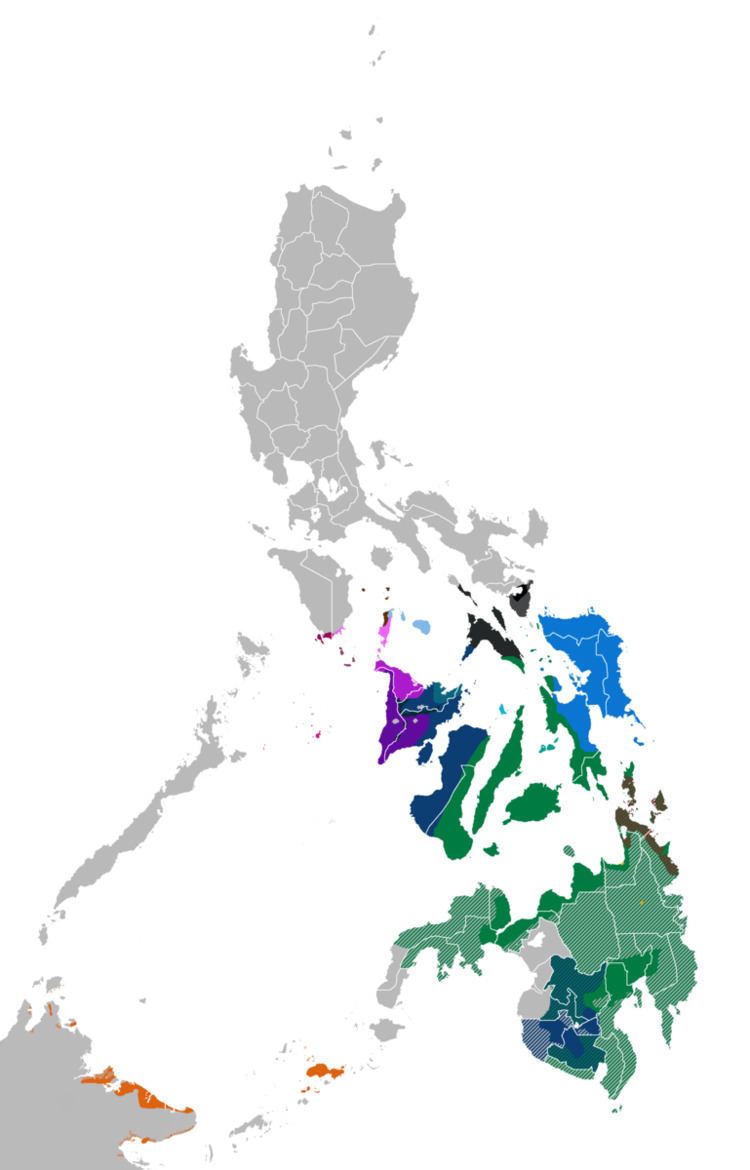Glottolog bisa1268 | ||
 | ||
Geographic
distribution Visayas, most parts of Mindanao, Masbate, and Mimaropa in the Philippines, Sabah in Malaysia and immigrant communities Linguistic classification Austronesian
Malayo-Polynesian
Philippine
Central Philippine
Visayan Subdivisions Asi
Cebuan
Central Visayan
West Visayan
South Visayan (Surigaonon, Butuanon, Tausug) | ||
Visayan or Bisaya or Binisaya is a group of languages of the Philippines that are related to Tagalog and Bikol, all three of which are part of the Central Philippine languages. Most Visayan languages are spoken in the whole Visayas section of the country, but they are also spoken in the Bicol Region (particularly in Masbate), islands south of Luzon, such as those that make up Romblon, most of the areas of Mindanao and the province of Sulu located southwest of Mindanao. Some residents of Metro Manila also speak Visayan.
Contents
Over 30 languages constitute the Visayan language family. The Visayan language with the most speakers is Cebuano, spoken by 20 million people as a native language in Central Visayas, parts of Eastern Visayas, eastern Negros Island Region and most of Mindanao. Two other well-known and widespread Visayan languages are Hiligaynon (Ilonggo), spoken by 10 million in most of Western Visayas, western Negros Island Region and SOCCSKSARGEN, and Waray-Waray, spoken by 3 million in Eastern Visayas.
Nomenclature
Native speakers of Visayan languages, especially Cebuano, Hiligaynon and Waray not only refer to their language by their local name, but also by Bisaya or Binisaya, meaning Visayan language. This is misleading or may lead to confusion as different languages may be called Bisaya by their respective speakers despite their languages being mutually unintelligible. However, languages that are classified within the Visayan language family but spoken natively in places outside of the Visayas do not use the self-reference Bisaya or Binisaya. To speakers of Masbateño, Romblomanon, Surigaonon and Butuanon, the term Visaya usually refers to either Cebuano or Hiligaynon. Since Tausugs are mostly Muslims, they view the term Bisaya as a religious term referring to Christian Filipinos (mostly referring to either Cebuano and/or Hiligaynon as they are the neighboring languages).
There have been no proven accounts to verify the origins of Bisaya. However, there is an ethnic group in Malaysia and Brunei who call themselves with the same name. However, these ethnic groups in the Philippines must not be confused with those in Borneo.
Internal classification
David Zorc gives the following internal classification for the Visayan languages (Zorc 1977:32). The five primary branches are South, Cebuan, Central, Banton, and West. However, Zorc notes that the Visayan language family is more like a dialect continuum rather than a set of readily distinguishable languages. The South Visayan languages are considered to have diverged first, followed by Cebuan and then the rest of the three branches. Also, in the Visayas section, the province of Romblon has the most linguistic diversity, as languages from three primary Visayan branches are spoken there aside from the indigenous Romblomanon and Banton.
Notably, Baybayanon and Porohanon have Warayan substrata, indicating a more widespread distribution of Waray before Cebuano speakers started to expand considerably starting from the mid-1800s.
A total of 36 varieties are listed below. Individual languages are marked by italics.
The auxiliary language of Eskayan is grammatically Visayan, but has essentially no Visayan (or Philippine) vocabulary.
Ethnologue Classification
Ethnologue classifies the 25 Visayan languages into five subgroups:
Reconstruction
David Zorc's reconstruction of Proto-Visayan had 15 consonants and 4 vowels (Zorc 1977:201). Vowel length, primary stress (penultimate and ultimate), and secondary stress (pre-penultimate) are also reconstructed by Zorc.
